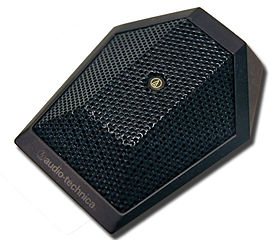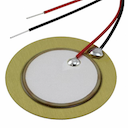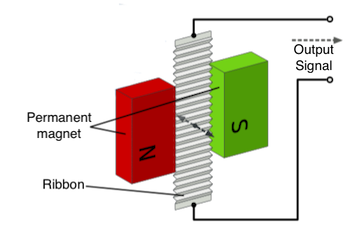Chapter Two: Studio Gear

3. Microphones | Page 3
Microphone Types
There is an incredible variety of microphones available on the commercial and used market, from a $5 karaoke special to microphones costing $20,000 and up for a vintage tube type.
For all this variety, most fall into one of the five following basic types:
Dynamic | Condenser | Ribbon | Boundary (PZM) | Contact
Dynamic Mic: Electrical generators create current by passing coils of conductive wire past magnets. This principle is known as induction. A dynamic microphone works on the same principle. A coil of thin wire (or a thin metal ribbon) called a voice coil is attached to the diaphragm. The wire is coiled around or inside a fixed magnet, separated from it by a very small gap. As sound waves sympathetically flex the diaphragm, they cause the coil to move into and out of the magnetic field of the magnet, thereby producing a fluctuation in the current moving through the coil (pictured below). These are often referred to as moving-coil dynamic mics. As mentioned, they are essentially small loudspeakers in reverse.
Dynamic mics are best used for loud sounds or sound that may contain sharp transients, as they can handle extremely high SPL's without distortion. The are not as good for minute detailed sounds and usually do not have the high frequency response of a condenser microphone because of the added mass of the coil attached to the diaphragm. Therefore, their frequency response is considered colored. While they can be omnidirectional when sound only hits the diaphragm from the front (called a pressure pickup), side acoustic ports and channels allow a time-delayed version of the front soundwave to also hit the rear of the diaphragm and phase cancel, thereby creating a cardioid pattern. This arrangement is called a pressure-gradient pickup. They are passive in that they require no phantom power to function, and they create virtually no self-noise due, in part, to their lack of a pre-amp. Their internal electronics are usually very simple, consisting of a transformer to step up the weak voltage from the coil, change impedence, and in some cases add a center tap to turn the mic output into a balanced signal. Dynamic mics are usually cheaper and more robust than condenser mics, so if your performer is planning a "drop the mic" moment, best to go with this type (though you'd be better off dropping the performer). The ubiquitous Shure SM57 and SM58 mentioned on the previous page are examples of dynamic microphones with pressure-gradient cardioid patterns and a balanced output.
Condenser Mics: A condenser mic works on an electrostatic principle, not an electromagnetic one, as in the dynamic mic. The capsule consists of two plates, separated by a very small distance, that are electrically charged, creating a capacitor or condenser-like response.
One of the plates, often called the backplate, is fixed; the other is part of the microphone diaphragm and is usually thinly gold-plated Mylar or similar thin film. As sound waves hit the diaphragm, the distance between the charged plates changes, producing equivalent fluctuations in the capacitance, and hence the flow of electrons across the gap. An additional component, a resistor, is attached across the leads of the two plates. It is the fluctuating voltage across the resistor that is sent out as the mic's signal. Almost all condenser mics are pressure-gradient, meaning part of the sound wave is let in behind the diaphragm through ports and a time-delaying narrow labyrinth. In addition, most condenser mics have a built-in preamp, though some attach to an external one. When a condenser mic distorts from acoustic overload, it is usually the preamp rather than the diaphragm that causes the issue. For this reason, these mics have attenuators to reduce the voltage into the preamp. However, it is best to remove this attenuation pad when not needed, as it will worsen the mic's signal-to-noise ratio if you need to crank the volume up for softer sounds. Vintage and vintage-based new mics may use an actual vacuum tube rather than an FET transistor in their preamp circuit for a "warmer" old-time sound. The ~$7,000 reissued Neumann U67, used to record Sinatra, the Beatles, etc. is an excellent example of a large-diaphragm tube condenser mic found in many high-end recording studios.
As can be seen on the following page many condenser mics feature a second capsule attached to the rear of the backplate. By varying the polarity and strength of the signal from the rear capsule (often with switches on the microphone), multiple patterns can be obtained from the same microphone. If the front and rear capsules are in phase, an omnidirectional pattern is created. If the phase of the rear capsule were inverted, then a variety of patterns, from cardioid to figure-8 can be had by varying the amount of signal from the rear capsule. Some microphones feature an infinitely variable pattern adjustment.
To charge the plates, condenser mics need a form of power called phantom power. This is supplied by most professional mixing consoles or digital audio interfaces and is usually labeled +48 volts DC or PWR — if you need phantom power from the board, look for a switch on individual channels or channel groups. Phantom power from a console or interface requires a balanced line, since the shield carries part of the charge (pins 2&3). Some condenser microphones are self-powered with a battery, designed to go dead at the worst possible moment. Some mics, such as the Røde NT5's, can run on either phantom power or a battery, and small wireless mics use a smaller charge, often in a belt pack. AKG C414 mics are condenser mics, and they do require phantom power.
Condenser mics normally have superior, flatter frequency response compared dynamic mics but are much more sensitive to high SPL transients. So, they are good for recording most instruments, and small bug noises — bad for close-mic'ing bass drums and Howitzers.
A variation of a condenser mic is called an electret or electret-condenser. This mic type has a permanently charged element (a special capacitor that acts like a magnet) requiring no phantom power. Better versions will have an internal pre-amp that does require power. Often, these are of back electret design, meaning the electret material is applied to the backplate and thus allows for better frequency response by not impeding the diaphragm. Electrets can, however, lose their charge or efficiency in high temperature and humidity, also with age.
Ribbon: Ribbon mics work on yet another principle, which responds to the velocity of the air molecules, not just the SPL of sound passing over its element. An unbelievably thin corrugated ribbon of aluminum — or more recently a polyester film with aluminum printed on it — is placed over a magnet or between magnets (or oppositely-charged plates). As the film moves when hit by air molecules, the changes in induction between the ribbon and the magnets produce a fluctuating current, much like a dynamic mic. Because these voltage changes are so small, like the condenser mic, however, a pre-amp, either internal or external is required. The electronics also balance the output in most newer versions. Ribbon mics have been around for a century, often seen on the desks of late-night TV hosts, or hanging from the ceiling in wrestling rings. However, newer mics such as the Beyerdynamic M160 , in addition to the printed ribbon may also use rare earth magnets that allow for a much smaller capsule. You may see these in some of the "ball" design mics. They also require phantom power to charge the magnet-like plates and ribbon.
Boundary or PZM: Short for pressure zone microphone, PZM (which is a trademarked by Crown) or a boundary microphone uses a small electret element suspended over the backplate, sometimes facing it, sometimes parallel to it. The capsule is mounted to the large, flat backplate which picks up the reflected waves from the surface, thereby doubling its output from that constructively amplified pressure zone, as we saw on the reflection page. Because it is placed on a surface, the polar pattern is normally half of a regular mic, so it creates a hemisphere of sensitivity above and around the mic. While used for low quality recordings of business meetings or perhaps CIA interrogations by putting a PZM mic in the center of a conference table, newer quality mics are now being used for sound-reinforcing pianos, inside the lid with less feedback possibilities. One issue is that if the surface it is mounted on is too small, lower frequencies will not be reflected due to their larger wavelengths. Some recording engineers use boundary mics, such as the Shure SM-91, inside kick drums since overloading is nearly impossible.

Audio-technica ATM87R
Contact or Piezoelectric Mic: A contact mic or pickup is a thin disk containing ceramics or a crystal that creates electric current when flexed or stressed. The disk is normally stuck to or clamped onto an instrument, receives most if its audio signal from the mechanical vibration of the object it is attached to utilizing piezoelectric principles (discovered by M. and Mme. Curie in 1880). It is often used for mic'ing instruments where feedback or unwanted sounds from other instruments would be an issue. It can also be attached to home-made instruments and pretty much anything that vibrates mechanically. Cheap piezo pickups can be home-made from inexpensive electronic supply company buzzers, usually by chipping off their outer plastic covering.

An electric buzzer with its case removed can be used as a contact microphone
One of the drawbacks of using a contact microphone on acoustic instruments is that it emphasizes frequencies resonating at a particular spot on the instrument, thereby creating a misrepresentation of the overall timbre of the instrument. For this reason, many performers have gone back to acoustic microphones or clip-on condenser mics, such as the DPA or ATM line. When using contact mics, experiment with different placements on the instrument, be it a string bridge or a clarinet barrel.

